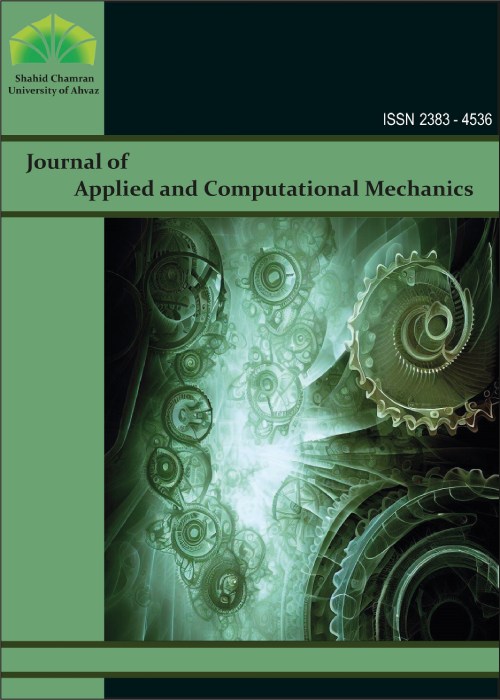فهرست مطالب

Journal of Applied and Computational Mechanics
Volume:2 Issue: 3, Summer 2016
- تاریخ انتشار: 1395/06/30
- تعداد عناوین: 6
-
-
Pages 128-133Plates and shells are significant structural components in many engineering and industrial applications. In this study, the free vibration analysis of annular plates is investigated. To this aim, two different numerical methods including the differential quadrature and the discrete singular convolution methods are performedfor numerical simulations. Moreover, the Frequency values are obtained via these two methods and finally, the performance of these methods is investigated.Keywords: Differential quadrature, discrete singular convolution, annular plate, free vibration
-
Pages 134-143This study provides an approach to predict the springback phenomenon during post-solidification cooling in a functionally graded hybrid composite cylindrical shell with a transverse isotropic structure. Here, the material properties are given with a general parabolic power-law function. During the theoretical analysis, an appropriate transformation is introduced in the equilibrium equation, which is resulting in a hypergeometrical differential equation. Thermoelastic solutions are obtained and analyzed for a homogeneous, nonhomogeneous, and elastic-plastic state. The solution is validated by applying it to the multilayered functionally graded cylindrical shell using the transfer or propagator matrix method.Keywords: Thermoelasticity, Functionally Graded Hybrid Composites, Cylindrical shell, Spring Backward Effect
-
Pages 144-151The efficiency and robustness of reliability methods are two important factors in the first-order reliability method (FORM). The conjugate choice control (CCC) and directional chaos control method (DCC) are developed to improve the robustness and efficiency of the FORM formula using the stability transformation method. In this paper, the CCC and DCC methods are applied for the reliability analysis of a nanocomposite beam as a complex engineering problem, which is reinforced by carbon nanotubes (CNTs) under buckling force. The probabilistic model for nanocomposite beam is developed through the buckling failure mode which is computed by using the Euler-Bernoulli beam model. The robustness and efficiency CCC and DCC are compared using the stable solution and a number of call limit state functions. The results demonstrate that the CCC method is more robust than the DCC in this case, while the DCC method is simpler than the CCC.Keywords: Reliability analysis, Nanocomposite beam, Conjugate chaos control, Directional chaos control
-
Pages 152-173The finite element method is employed for the flexural-torsional linear buckling analysis of beams of arbitrarily shaped composite cross-section taking into account generalized warping (shear lag effects due to both flexure and torsion). The contacting materials, that constitute the composite cross section, may include a finite number of holes. A compressive axial load is applied to the beam. The influence of nonuniform warping is considered by the usage of one independent warping parameter for each warping type, i.e. shear warping in each direction and primary as well as secondary torsional warping, multiplied by the respective warping function. The calculation of the four aforementioned warping functions is implemented by the solution of a corresponding boundary value problem (longitudinal local equilibrium equation). The resulting stress field is corrected through a shear stress correction. The equations are formulated with reference to the independent warping parameters additionally to the displacement and rotation components.Keywords: Nonuniform warping, Shear lag, Shear deformation, Composite beams, Flexural, torsional buckling
-
Pages 174-191The composites provide design flexibility because many of them can be moulded into complex shapes. The carbon fibre-reinforced epoxy composites exhibit excellent fatigue tolerance and high specific strength and stiffness which have led to numerous advanced applications ranging from the military and civil aircraft structures to the consumer products. However, the modelling of the beams undergoing the arbitrarily large displacements and rotations, but small strains, is a common problem in the application of these engineering composite systems. This paper presents a nonlinear finite element model which is able to estimate the deformations of the fibre-reinforced epoxy composite beams. The governing equations are based on the Euler-Bernoulli beam theory (EBBT) with a von Kármán type of kinematic nonlinearity. The anisotropic elasticity is employed for the material model of the composite material. Moreover, the characterization of the mechanical properties of the composite material is achieved through a tensile test, while a simple laboratory experiment is used to validate the model. The results reveal that the composite fibre orientation, the type of applied load and boundary condition, affect the deformation characteristics of the composite structures. The nonlinearity is an important factor that should be taken into consideration in the analysis of the fibre-reinforced epoxy composites.Keywords: Anisotropic elasticity, composite material, large displacement
-
Pages 192-199A new multiple C-slotted microstrip patch antenna is proposed in the present study. A patch antenna is a wide-beam narrowband antenna. The microstrip patch antenna consists of a very thin metallic strip (patch) placed a small fraction of a wavelength above a ground plane. The patch can be designed in any possible shape and normally made of conducting materials such as copper or gold. This study presents a design of a C-Slotted microstrip patch antenna for multiple applications. The proposed antenna's characteristics include a low cost, easy fabrication and good isolation along with Quad different frequency bands which are centered at 1.60 GHz, 2.50 GHz, 4.70 GHz and 5.50 GHz for parameter S11. The antenna is designed, simulated, and optimized for Quad band performance by using IE3D software. The C-shape-slotted patch antenna is designed on a FR4 substrate with the thickness of 1.59 mm and the relative permittivity of 4.4. The proposed patch dimension is 16*16 mm and it utilizes the microstrip line feed. The simulated results parameter S11 and S12, shows that the antenna can cover the bands of several applications including GPS (1.2-1.6 GHz), GSM (1.8-1.9 GHz) and WiMAX (2.3-5.8 GHz). Simulation results are presented in terms of Resonant Frequency, Return Loss, Voltage Standing Wave Ratio (VSWR) and Radiation Pattern.Keywords: Microstrip antenna, Slotted patch, GPS, GSM, WiMAX


